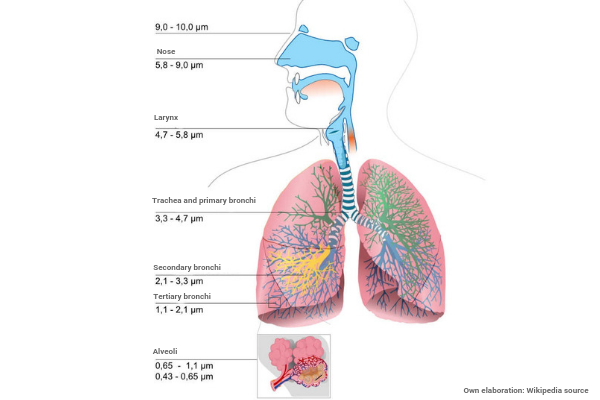Non-polluting and polluting suspended particles (types of polluting suspended particles) are one of the substances present in the air that generate most of health problems. This damaging impact is due to their small size, which makes it possible for them to reach the deepest part of the respiratory system and even the bloodstream.
Characterization of polluting and non-polluting suspended particles
Suspended particles can be considered as a sum of solid and liquid compounds (except pure water) that float in the air. However, sedimentable particles with a diameter greater than 20 µm also tend to be included under this denomination (Viana, 2003).
Its physical characteristics, chemical composition and emission sources are analyzed in the following sections.
Physical characteristics of suspended particles
The size of the particles is one of the most important physical variables, being a fundamental factor in determining their degree of affection on human health. Although for its classification it is alluded to the diameter or the radius, implying that the particles have a spherical shape, Salvador (2004) recalls that it is an equivalent measure, since “in nature the particles generally have very irregular shapes.”
The classification of particles by size varies depending on the discipline of study (atmospheric sciences, epidemiology, etc.) or if the formation processes are taken into account, in which case we speak of “styles”. However, for this article and with the objective of resorting to denominations that begin to be recognized by large population groups, it has been decided to consider only the granulometric fraction used in the field of air quality, that is:
- Total suspended particles (PST), which in Spain are not regulated by legislation but which countries like Canada define as particles “with an upper size limit of approximately 100 micrometers or microns (µm) of aerodynamic equivalent diameter” (1).
- PM10, particles with a diameter of less than 10 microns (µm).
- PM2.5, particles with a diameter of less than 2.5 microns (µm).
- PM1, particles with diameter of less than 1 micron (µm).
The following image shows a scheme of the human breathing system and the degree of penetration of the particles according to their size.

Chemical characteristics of suspended particles
The chemical composition of the particles varies according to the emitting source, the formation process, which can have a natural or anthropogenic origin, and the mechanism, which can be primary or secondary. Thus, for example, the particles of the coastal will have a large amount of sodium chloride, while those from combustion engines will have a mixture of coal, metals and sulfates.
However, and as detailed by Mejía & Páramo (2011), a series of major and minor compounds that are listed below can be distinguished:
- Major compounds, which represent the bulk of mass and among which there are sulfates, nitrates, ammonium, sodium and chlorine, elemental carbon, organic coal, mineral components and water.
- Minor compounds, additionally present in the form of trace elements, represented by heavy metals such as lead, cadmium, mercury, nickel, chromium, zinc or manganese, and trace organic compounds, which are formed by polycyclic aromatic hydrocarbons (PAHs) and aliphatic, aldehydes, carboxylic acids and ketones.
Regarding the impact that, considering their composition, the particles have on human health, it is worth noting a study that warns about the harmful effects that substances of metallic origin could have (Lequy et al., 2019). The research suggests that some atmospheric anthropogenic metals may be associated with excess mortality, even in areas with relatively low levels of exposure to air pollution.
Sources and mechanisms of particle formation
The particles also admit a characterization depending on the source and the formation process.
In this sense, 4 large groups can be distinguished (Salvador, 2004):
- Primary natural emissions, consisting of the resuspension of soil dust, volcanic eruptions, marine spray and biogenic emissions. A clear example of this type of particles is the Saharan dust that occasionally causes pollution peaks in various European cities.
- Primary anthropogenic emissions, which correspond to the emanations of combustion facilities and road transport and usually give rise to carbonaceous particulate material (elemental and organic) and polluting suspended particles represented by heavy metals.
- Secondary inorganic compounds, such as sulfates and nitrates indicated in the previous section, which are formed by atmospheric reactions of sulfur dioxide (SO2) and nitrogen oxides (NOx).
- Secondary organic compounds, such as volatile organic compounds that are formed from vegetation emissions and that are encompassed within ultrafine particles or PM2.5 or secondary organic aerosols resulting from the transformation of aromatic non-methane hydrocarbons of gasoline.
In summary and as it can be seen, the characterization of the polluting and non-polluting suspended particles varies depending on their size, chemical composition or origin. However, and regardless of their typology, they are all likely to be monitored through the air quality networks and IoT devices that ENVIRA installs, configures and maintains.
References:
– (1) Environment Canada. (2013). Particulate matter 2.5 and 10. Canada.ca. https://www.canada.ca/en/environment-climate-change/services/air-pollution/pollutants/common-contaminants/particulate-matter.html
– (2) Spain. Royal Decree 102/2011, of January 28, regarding the improvement of air quality. Official State Gazette, January 29, 2011, no. 25, pp. 9574 to 9626. https://www.boe.es/boe/dias/2011/01/29/pdfs/BOE-A-2011-1645.pdf
– Lequy, E., Siemiatycki, J., Leblond, S., Meyer, C., Zhivin, S., & Vienneau, D. et al. (2019). Long-term exposure to atmospheric metals assessed by mosses and mortality in France. Environment International, 129, 145-153. doi: http://doi.org/c6tk
– Mejía, G., & Páramo, V. H. (rev.). Methodological guide for the estimation of PM emissions 2.5. Mexico D.F .: Ministry of Environment and Natural Resources. National Institute of Ecology (2011). ISBN 978-607-8246-52-6. http://biblioteca.semarnat.gob.mx/janium/Documentos/Ciga/libros2009/225459.pdf
– Salvador, P. (2004). Characterization of air pollution caused by suspended particles in Madrid. (Complutense University of Madrid). https://eprints.ucm.es/5402/
– Viana, M. (2003). Levels, composition and origin of the atmospheric particulate material in the North and East sectors of the Iberian Peninsula and the Canary Islands (University of Barcelona). http://hdl.handle.net/10261/27476











